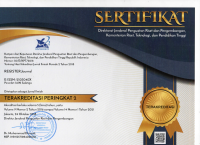An Exploration of EFL Teachers’ Challenges and Strategies during the Pandemic: A Case of Emergency Blended Synchronous Education
Abstract
With the lockdowns caused by the COVID-19 pandemic, educational institutions had to make swift educational decisions such as emergency blended synchronous education without thoroughly scrutinizing its effects. This study explores the experiences of a group of seven EFL teachers of a blended learning model during the pandemic in Northern Cyprus higher education. The study adopted a qualitative design by interviewing seven teachers on their experiences during the pandemic, particularly focusing on a blended instructional mode of education over the fall academic semester in 2020. The study results reveal that the study participants employed various strategies to cope with the challenges ascribed to the blended mode of delivery. The study's findings offer some implications for second language teachers and the use of technology in second language education.
Keywords: EFL teachers, challenges, emergency blended synchronous education, blended education
Full Text:
PDFReferences
Adedoyin, O. B., & Soykan, E. (2020). Covid-19 pandemic and online learning: the challenges and opportunities. Interactive Learning Environments, 1-13. https://doi.org/10.1080/10494820.2020. 1813180
Abdelmalak, M. M. M., & Parra, J. L. (2016). Expanding learning opportunities for graduate students with HyFlex course design. International Journal of Online Pedagogy and Course Design, 6(4), 19–37. https://doi.org/ 10.4018/IJOPCD.2016100102
Anderson, T. (2008). Towards a theory of online learning. In T. Anderson (Ed.), The theory and practice of online learning (pp. 45-74). AU Press.
Atmojo, A. E. P., & Nugroho, A. (2020). EFL classes must go online! Teaching activities and challenges during COVID-19 pandemic in Indonesia. Register Journal, 13(1), 49-76.
Barron, M., Cobo, C., Munoz-Najar, A., Sanchez Ciarrusta, I. (2021). The changing role of teachers and technologies amidst the COVID 19 pandemic: Key findings from a cross-country study. https://blogs.worldbank.org/ education/changing-role-teachers-and-technologies-amidst-covid-19-pandemic-key-findings-cross
Bower, M., Lee, M. J., & Dalgarno, B. (2017). Collaborative learning across physical and virtual worlds: Factors supporting and constraining learners in a blended reality environment. British Journal of Educational Technology, 48(2), 407–430. https://doi.org/10.1111/ bjet. 12435
Dixson, M. D. (2010). Creating effective student engagement in online courses: What do students find engaging? Journal of the Scholarship of Teaching and Learning, 10(2), 1-13. Dodge, R., Daly, A. P., Huyton, J., & Sanders, L. D. (2012). The challenge of defining wellbeing. International Journal of Wellbeing, 2(3). 222-235. https:// doi:10.5502/ijw.v2i3.4
Graham, C. R., Woodfield, W., & Harrison, J. B. (2013). A framework for institutional adoption and implementation of blended learning in higher education. The Internet and Higher Education, 18, 4-14.
Garrison, D. R., Anderson, T., & Archer, W. (1999). Critical inquiry in a text-based environment: Computer conferencing in higher education. The internet and higher education, 2(2-3), 87-105.
Garrison, D. R. & Kanuka, H. (2004). Blended learning: Uncovering its transformative potential in higher education. The Internet and Higher Education, 7(2), 95-105.
Hartshorn, K. J., & McMurry, B. L. (2020). The effects of the COVID-19 pandemic on ESL learners and TESOL practitioners in the United States. International Journal of TESOL Studies, 2(2), 140-156. https://doi.org/10.46451/ijts.2020.09.11
Hrastinski, S. (2019). What do we mean by blended learning? TechTrends, 63, 564–569. https://doi.org/10.1007/s11528-019-00375-5
Hughes, J. [National Geographic Learning – ELT]. (2020, December 3). Making your online language teaching positive, practical, and personal [Video]. YouTube. https://www.youtube.com/watch?v=YvAT1oLtvns &t=928s
Kim, L. E., Oxley, L. & Asbury, K. (2021) “My brain feels like a browser with 100 tabs open”: A longitudinal study of teachers’ mental health and wellbeing during the COVID-19 pandemic in 2020. British Journal of Educational Psychology. Advance online publication. https://doi:10.1111/bjep.12450
MacIntyre, P. D., Gregersen, T., & Mercer, S. (2020). Language teachers’ coping strategies during the Covid-19 conversion to online teaching: Correlations with stress, wellbeing and negative emotions. System, 94, 102352. https://doi.org/10.1016/j.system.2020.102352
McAleer, M. (2020). Prevention is better than the cure: Risk management of COVID-19. Journal of Risk and Financial Management, 13(3), 1-5.
McCallum, F., Price, D., Graham, A., & Morrison, A. (2017). Teacher wellbeing: A review of the literature. AIS: NSW, The University of Adelaide, Australia, 34.
McKimmy, P. B., & Schmidt, M. (2014). HOT Classroom: Iterations on equipping a here-or-there instructional space. The International Convention of the Association for Educational Communications and Technology, Jacksonville, FL.
McKimmy, P.B., & Schmidt, M. (2015). HOT instruction: Equipping a here-or-there classroom. The 20th Annual Technology, Colleges & Community Worldwide Conference. Honolulu, HI.
Nortvig, A. M. (2013). In the presence of technology: Teaching in hybrid synchronous classrooms. In M. Ciussi, & M. Augier (Eds.), Proceedings of the 12th European Conference on E-Learning (1st ed., pp. 347-353). Academic Conferences and Publishing International. http://academic-conferences.org/ecel/ecel2013/ecel13-proceedings.htm
O’Byrne, W. I., & Pytash, K. E. (2015). Hybrid and blended learning: Modifying pedagogy across path, pace, time, and place. Journal of Adolescent & Adult Literacy, 59(2), 137-140.
Patton, M. Q. (2015). Qualitative research and evaluation methods (4th ed.). Sage.
Raes, A., Detienne, L., Windey, I., & Depaepe, F. (2020). A systematic literature review on synchronous hybrid learning: Gaps identified. Learning Environments Research, 23(3), 269-290. https://doi.org/ 10.1007/s10984-019-09303-z
UNESCO. (2021). COVID-19: reopening and reimagining universities, survey on higher education through the UNESCO National Commissions. https://unesdoc.unesco.org/ark:/48223/pf0000378174
UNESCO, UNICEF & World Bank. (2020). What have we learnt? : Overview of findings from a survey of ministries of education on national responses to COVID-19. UNESCO, UNICEF, World Bank. https://openknowledge. worldbank.org/handle/10986/34700
Velavan, T. P., & Meyer, C. G. (2020). The COVID-19 epidemic. Tropical Medicine & International Health, 25(3), 278-280. https://doi.org/ 10.1111/tmi.13383
Whittaker, C. (2013). Introduction. In B. Tomlinson & C. Whittaker (Eds.), Blended learning in English language teaching (pp. 9-23). British Council.
COVID-19 pandemic in Northern Cyprus. (2021, August 20). In Wikipedia. https://en.wikipedia.org/wiki/COVID-19_pandemic_in_Northern_ Cyprus#cite_note-23
Yi, Y., & Jang, J. (2020). Envisioning possibilities amid the COVID‐19 pandemic: Implications from English language teaching in South Korea. TESOL Journal, 11(3). https://doi.org/10.1002/tesj.543
Zydney, J. M., McKimm, P., Lindberg, R., & Schmidt, M. (2019). Here or there instruction: Lessons learned in implementing innovative approaches to blended synchronous learning. TechTrends, 63, https://doi.org/ 10.1007/s11528-018-0344-z
DOI: https://doi.org/10.18326/rgt.v15i1.1-19
Refbacks
- There are currently no refbacks.
Copyright (c) 2022 Mehmet Kanık, Abbas Hadizadeh

This work is licensed under a Creative Commons Attribution-ShareAlike 4.0 International License.











